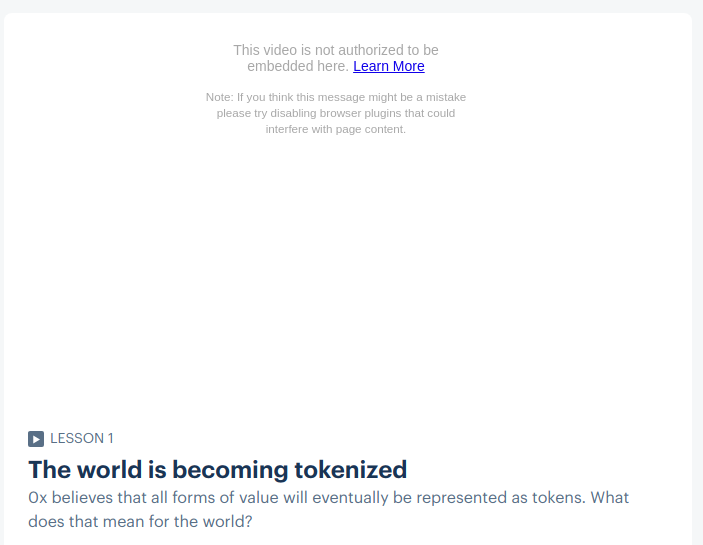Coinbase is going big this Christmas. To much fanfare, the exchange has just launched Coinbase Earn, a new initiative where Coinbase users can be paid to watch education videos about certain coins and tokens listed on the platform.
Coinbase Earn was rolled out as part of the company’s 12 Days of Coinbase series, where new features are announced on 12 consecutive days. Previous announcements have included e-gift cards (boring), instant PayPal withdrawals (cool), and a YouTube video (not really a gift) among other things.
The first project to be featured in the paid video series is 0x, a decentralized protocol for token exchange. An announcement on the 0x blog said:
The 0x Core Team has allocated 1,600,000 ZRX tokens from our external development pool for the initiative. 100% of these tokens will be distributed to Coinbase Earn participants. We look forward to supporting other programs aiming to educate and assist people in interacting with 0x and complementary protocols in the DeFi community. […] After watching each video and answering a simple quiz, users will earn $1 in ZRX tokens that will appear directly in their wallets on Coinbase.com.
Currently, Coinbase Earn is invite-only (i.e., only a small number of people who already had Coinbase accounts received an email invitation). I wanted to test it but I didn’t get an invite, and even if I had, I’m in the middle of painfully slow support request to try and unlock my old Coinbase account after I switched phone numbers, so I wouldn’t have been able to use it anyway.
That being the case, I decided to forego the $1 reward and watch 0x’s videos without compensation. Until I hit a snag.
When I first tried to watch the video I got an error message due to a tracker-blocking browser plugin (shoutout Privacy Badger). In order to watch it I had to disable the extension and agree to be tracked, which always predisposes me to hating whatever service I’m about to receive.
With that said, the first video was boring and didactic with some OK graphics and a V/O from an emotionally-neutral-but-assertive-sounding woman, so pretty much exactly what you’d expect all round. But watching it did give me some time to reflect on the project, and the interesting conceptual re-framing that has happened in terms of target audience.
The launch of Coinbase Earn is the product of Coinbase’s $100 million acquisition of Earn.com, which was mostly seen as a super expensive way to hire Earn founder Balaji Srinavasan, now Coinbase CTO. Earn.com, a site where users can earn bitcoin for responding to messages or performing simple tasks, was built on the premise that for busy people tasks requiring even small amounts of time should be monetizable: The people paying for the busy and/or prestigious people to respond to them were usually less prestigious, and so were willing to pay for the privilege of contacting wealthier, more time-starved targets.
In some ways, the incorporation of Earn.com into the new Coinbase Earn platform has led to an inversion of that formula. As per the 0x announcement, the total payout for learning about their product is one dollar in tokens, for watching three videos of two minutes each. That works out at a total time valuation of $10/hour, which is above minimum wage in states like Arkansas ($9.25), Idaho ($7.25) and Nebraska ($9), but probably has a limited appeal for anyone making significantly more than that.
The people paying for the busy and/or prestigious people to respond to them were usually less prestigious, and so were willing to pay for the privilege of contacting wealthier, more time-starved targets.
Coinbase Earn is really more like a direct-marketing scheme: Instead of the featured project paying a small amount of money to put advertisements in front of people who may or may not respond or even see it in the first place, a larger amount of money is paid directly to users who engage with content that promotes the brand. The smart part is that video watchers are rewarded in the cryptocurrency they’ve just watched an advert about, which adds to the strength of the positive association they’re in the process of forming, and (if all goes to plan) tempts them to buy more of the same asset later.
This seems like a good way of seeding a cryptocurrency; compared to an airdrop, there’s at least some sense that users have an interest in the product, rather than a purely financial stake. Also, there’s a lot to like in the idea that viewers should be paid to watch ads they’ve opted into, instead of being bombarded by ads they don’t want to watch for no compensation at all. (For that matter, Brave’s BAT token is based on a similar desire to recalibrate the power dynamic between the buyers, distributors, and watchers of advertisements, although the underlying mechanics are a little different.)
After watching the second of 0x’s videos—this one on the decentralized protocol—I was feeling more favorable towards the project, because personally I believe much more in the importance of decentralization than in the need to tokenize every possible asset and put it on the blockchain. I may not have earned any ZRX tokens, but I did learn more about an interesting project, which as a journalist is worth more than a dollar anyway.
Most of the coverage of Coinbase Earn has talked about “incentivizing the public to learn more about cryptocurrencies.” Suggesting that it will drive mainstream adoption seems misguided, since by definition, you’d already need to be interested in crypto to bother signing up to Coinbase and watching the featured videos. Still, it’s a better, more transparent way to advertise a project than banner ads or promoted tweets, and finding ways to compensate viewers for their time in addition can only be a good thing.
